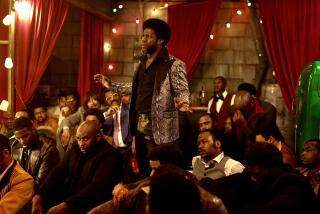From the archives:: Muhammad Ali: It’s ‘The Greatest’ lie of all
One of the things boxing as a sport doesn’t want to face up to is the true state of affairs concerning Muhammad Ali.
Is he a casualty of boxing, merely another piece of human flotsam thrown up by that cruel sport, or is he the victim of a disease that might have happened to him anyway?
Muhammad Ali probably was the most stunning physical specimen any sport ever produced. Fair of face, beauty of body, a quick mind, reflexes of a crouched leopard, he might have been anything in sports. Vince Lombardi, no less, once agreed he might have made a superb tight end. If someone had put a basketball in his hands instead of boxing gloves, he might have been as good a backcourt man as the game can produce. He certainly had the hand-eye coordination to be a great baseball player.
He chose pugilism. Or, pugilism chose him.
When he was a young Olympian, the sport seemed all too right for him. It suited his bombast, his reverence for the limelight. He was never really extended. It was an easy game for him. Three rounds of brilliant maneuvering, swiftness of hands and feet, a gold medal, picture on magazine covers. The good life. He never even got a nosebleed.
At first, the pros seemed more of the same. Ali didn’t have fights, he gave recitals. The world was overmatched. The dance would go on all night, all year, all decade. The public loved him. He wasn’t some drab, broken-nosed pug — he was an artist.
He had some amateur moves. He would jerk his head back at exactly the proper instant; he never really learned to slip punches. But he was so fleet of foot, so quick of instinct, he didn’t have to.
I remember one night my late wife, at a party at promoter Aileen Eaton’s house, took one look at Ali and his next opponent, Alejandro Lavorante, resplendent in white dinner jackets, and she moaned. “Who in the world would put two such beautiful specimens as you two in a ring to knock each other bloody?” she asked bitterly.
The next day, Ali incorporated it in the act. “I’m too pretty to fight these big ugly bears!” he would shout on cue. It joined the other shticks that made up the persona of Muhammad Ali.
Two years later, Alejandro Lavorante would be in a coma, dying a lingering death from the effects of beatings in the ring. Two decades later, Ali, the quick-witted, quick-tongued artist of the squared circle, would be a shambling, stumbling, stuttering, mumbling replica of himself.
Is boxing at fault here? It hopes not. It’s one thing for slow-moving, slow-witted second-raters to be going around sparring with light poles or tracking invisible flights of birds overhead. It brings a wince to apply that terrible adjective “punch drunk” to the purest specimen the game has seen, probably its greatest champion of them all.
So, it’s not surprising when promoters, managers, trainers and even announcers gravely convince themselves that Ali’s troubles are because of a disease that may have nothing to do with the prize ring — Parkinson’s disease. They don’t want to think the unthinkable. They don’t want Ali to be a terrible advertisement for their suspect industry.
But, comes now the medical man who knew Ali best to dispute them. Ferdie Pacheco was known to all of us as Ali’s doctor and even cornerman in many of his most important bouts. Ferdie was a man in good standing with the Ali’s considerable entourage.
Interestingly enough, it was not Ali’s brutal matches with Joe Frazier, Ken Norton or George Foreman that accelerated the downfall. It was that lunacy of a promotion pitting Ali against the Japanese wrestling champion, Antonio Inoki, a comic opera in which Inoki spent the night falling to the floor and kicking the back of Ali’s legs till they were masses of blood clots. Ali, says Pacheco, never recovered from those kicks.
That might be true. But most of us who were Ali watchers over the years had to vote for that horrible match in Manila when Ali and Joe Frazier put on probably the most terrible fight ever seen in a ring. Two careers were ended that awful night. Frazier finally had to quit in his corner, but when Ali was told it was over, he, too, immediately passed out in his own corner. Neither man was ever the same again. It made Dempsey-Firpo look like a minuet.
Ferdie Pacheco’s new book, “Muhammad Ali — A View From the Corner,” has the good doctor acknowledging: “It was about this time I first began having twinges of conscience.” The Hippocratic Oath kicked in.
It was after the subsequent Earnie Shavers-Ali fight that physical evidence began matching the observable deterioration in the Ali style. “Dr. Guardino came to me and discussed Ali’s lab work. His face was serious. The urine exam not only revealed blood in the urine, but entire sections of cells from the tubules. These cells filter the blood. They are not replaceable. They scar and impair kidney function. It is a serious finding, indicating impending kidney damage which could lead to grim consequences later in life,” Pacheco writes.
Pacheco quit the Ali camp when his warnings that Ali not fight again went unheeded.
The beatings Ali suffered in the ring were nothing compared to the ones he endured out of it, Pacheco writes. He disputed the diagnosis of Ali as suffering from hypothyroidism before the Larry Holmes fight in 1980, Ali’s last title shot. He saw thyroid shots as Ali’s way to quick weight loss for the fight. It was, Pacheco says, “a dangerous diagnosis.” He adds: “(It) was made with no provable lab test. The diagnosis is not made by running a blood sample through simple tests, but requires a radioactive iodine test. If hypothyroidism is the diagnosis, it is one that usually sticks with the patient for life. It is not episodic. It doesn’t go away like a headache after aspirin. So, when the doctor reported that, after a short course, Ali returned to normal and thyroid therapy was discontinued, that is not consistent with the course of hypothyroidism. Once you get it, you keep it.
“To give thyroid hormone to a healthy man (as he says was done with Ali before the Holmes fight) is very destructive. In addition to leading to thyroid deficiency, it raises the basal metabolism rate, which burns off fat and muscle tissue and raises the heartbeat. Reducing muscle mass in a boxer is like letting the air out of the tires of an Indy race car.”
Notes Pacheco: “Boxing apologists immediately claimed that Joe Louis’ problems stemmed from drugs, (Sugar Ray) Robinson’s from old age (he died from Alzheimer’s disease), and Ali’s from Parkinson’s disease.
“It is both bewildering and discouraging that supposedly intelligent men, without benefit of medical education or practical clinical experience, can airily dismiss boxing as the prime cause of these disorders.”
Pacheco says the linkage is inescapable. “By taking frivolous attitudes on TV (“He has Parkinson’s disease; boxing had nothing to do with it”), they undermine the work of boxing commissions and medical researchers who are struggling to limit the damages caused by the fighter’s boxing past his prime. Boxing should be curtailed. The less you box, the less the possibility of the PDS (punch-drunk syndrome), Parkinson’s disease and, maybe, Alzheimer’s disease.”
Note: This column was originally published on July 21, 1992.
More to Read
Go beyond the scoreboard
Get the latest on L.A.'s teams in the daily Sports Report newsletter.
You may occasionally receive promotional content from the Los Angeles Times.










